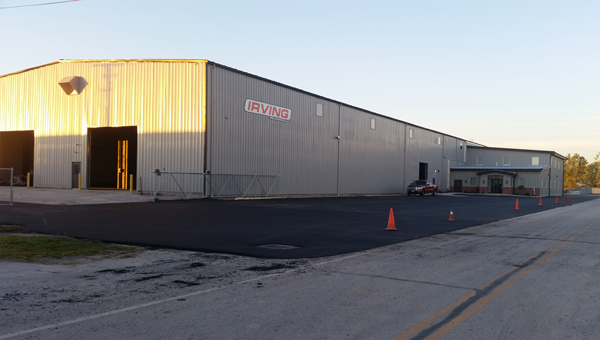CFA Adds First Certified Contractor in North Carolina
The state of North Carolina is the latest state to lay claim to residential concrete foundations constructed by a concrete professional that has achieved the status of Certified Residential Foundation Company, Doggett Concrete Construction of Charlotte, North Carolina has been approved this fall having met all program requirements and has been elevated to certified status.
The Certified Foundation Company distinction is a program rating established by the Concrete Foundations Association ™ of North America (CFA) offering third-party quality assurance for professional concrete foundation companies. Recognizing the need for a national program to establish a consistent base of knowledge and quality assurance for the cast-in-place concrete foundation industry, the CFA created the Certified Foundation Company a decade ago. The program now recognizes certified companies in the states of Missouri, Iowa, Pennsylvania, Illinois, Wisconsin, Nebraska and now Indiana and Utah.
“The Certified Foundation Company program was a natural by-product of the introduction of Certified Foundation Technician,” states Baty. “Introduced in 2007, the technician program established a grueling examination of the knowledge base for understanding the codes and standards that shape the minimum requirements for today’s residential concrete foundations. However, having a person on staff, or even multiple project managers that know the important sections of code documents, was just the start. This industry needed a recognizable standard for operation of a quality foundation company.”
A long-time member of the cast-in-place concrete industry and a member of the CFA for more than twenty years, Doggett Concrete Construction has met some tall challenges throughout the state’s foundation industry. Considered one of the elite cast-in-place concrete companies in the state, Doggett Concrete excels at both residential and commercial concrete construction projects throughout the Carolinas. Their project range spans from large commercial work such as stadiums and parking decks, hospitals and shopping centers to more intimate and personalized projects for homebuilders and residential customers for even projects as small as patios and sidewalk enhancements. Doggett Concrete is a specialist for helical pier installations as well as foundation repair and stabilization along with their new construction.
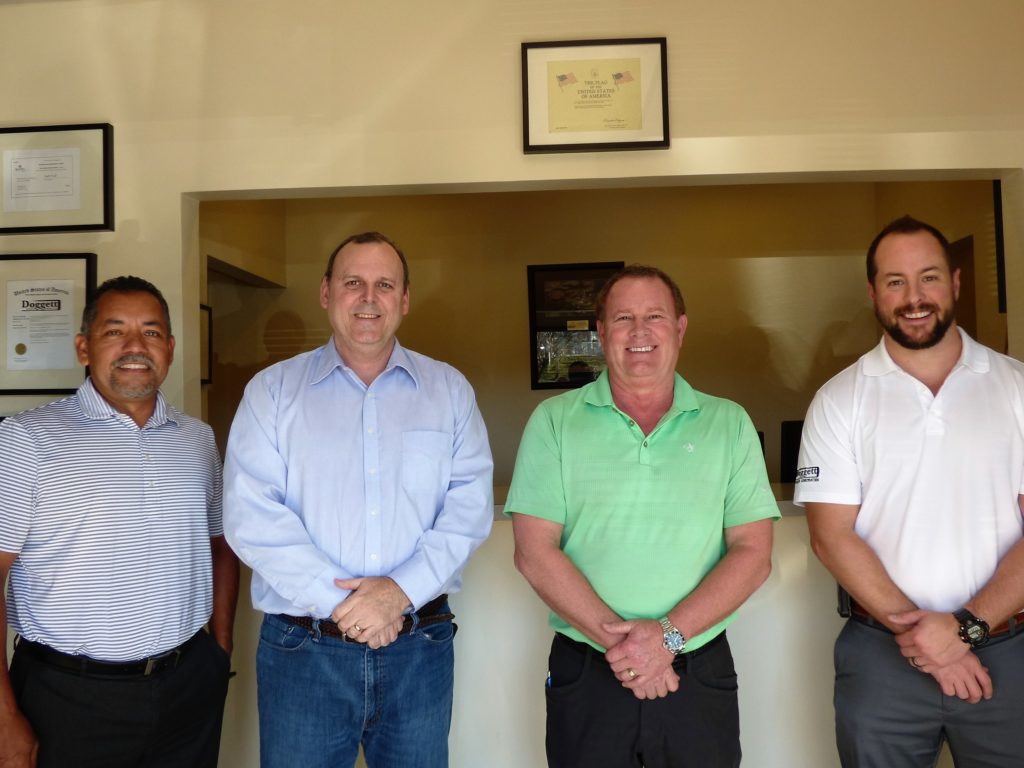
Doggett Concrete managers from left to right: Juan Melchor, Cletus Haas, Doug Doggett, and Ivey Stewart.
Company president, Doug Doggett began working becoming a certified company, knowing it would be an excellent opportunity to elevate his company among the many industry participants in the region. “What I wasn’t anticipating,” stated Doggett, “was the value of this certification in helping me and my company develop a much deeper and more thorough understanding of the way we can shape and own the future for our project work here in this state.”
What Doggett came to discover, which is in stride with companies throughout the program, is the development of a working understanding of the technical documents for design and construction of high-quality concrete foundations. Largely left to the minimal information found in the IRC, the program emphasizes awareness of many other technical standards and codes that contractors can use for a collaborative approach to higher quality and more effective constructions. In addition, the program establishes a communication platform for working with engineers, code officials and building inspectors to determine a more effective vocabulary for concrete foundations based on the local variables. “We have already transitioned to a higher level of communication with our building departments, helping them learn about the latest acceptable standards and determining what are the best paths to compliance and specific application here in North Carolina,” stated Doggett.
CFA Manager for Certifications, Ed Sauter, was impressed with the commitment to safety found in review of Doggett Concrete’s application. “It is imperative that safety plays a role in these companies and for the program, it is an essential component,” stated Sauter. “Doggett Concrete was very impressive with their commitment to OSHA certification for their crew chiefs and their weekly commitment to safety training. These elements certainly support the excellent safety record they have developed.”
CFA has further validated this commitment safety, recently awarding Doggett Concrete with the CFA’s Most Improved Safety Award for 2016 (numbers based on 2015). For more information on Doggett Concrete Construction, please contact Doug Doggett at (704) 554-9200 or visit their website, http://doggettconcrete.com.
For more information on the CFA, please contact James Baty, Executive Director, at 866-232-9255 or jbaty@cfawalls.org or visit the Association website at www.cfawalls.org and go to keyword Certification.
For more information on the American Concrete Institute and their individual certification programs visit their website, www.concrete.org.
Passing of CFA Member Lynn Berggren
Obituary: Lynn Roland Berggren
 Lynn Berggren was born Sept. 4, 1950, in Grand Island, to Myron and Margaret (Williams) Berggren. He grew up with his two sisters and graduated from Grand Island Senior High in 1968.
Lynn Berggren was born Sept. 4, 1950, in Grand Island, to Myron and Margaret (Williams) Berggren. He grew up with his two sisters and graduated from Grand Island Senior High in 1968.
Lynn attended Kearney State College, where he met wife Jeanne. They graduated in May 1973, married in June, and moved to Broken Bow Sept. 4, 1973.
Lynn was a third generation contractor; together with Jeanne they built Berggren Home Builders. Their business grew from small commercial and general construction to serving a 90 mile radius in central Nebraska for any poured walls and agricultural construction. Many people have played an integral part, including their first employee, Mike Bell, and long-time employee, Randy Nielsen. Son, Patrick and wife Tristan moved to Broken Bow to continue as the fourth generation of Berggren contractors.
Lynn’s passion for the outdoors started at an early age with his father, Myron, and uncle, Oliver. These passions were continued with his wife, kids, and grandkids; unforgettable memories of weekends at Johnson Lake, countless hunting and fishing excursions, and other outdoor activities. Life was celebrated regularly with 5 p.m. happy hour, family, and friends.
Lynn and Jeanne had three children: Patrick, Becky and Kevin. Lynn cherished practicing and coaching his kids in basketball throughout their school years, as well as their classmates and peers. He took great joy in teaching his kids and grandkids how to hunt and fish.
One of his most proud moments was being appointed by Governor Heinman to serve on the Nebraska Game and Parks Commission in 2007. He served for two terms representing 21 counties and was commission chairman in 2014.
Lynn was a supporter and advocate for wildlife conservation, habitat management and improving opportunities to enjoy the outdoors. He worked tirelessly to make all the Nebraska outdoors, including public hunting, fishing and other activities, accessible and enjoyable for all ages and was actively involved in educating Nebraska youth about the great outdoors.
He was a cherished member of the Broken Bow community with on-going involvement in many organizations. He was a founding member of Broken Bow Economic Development, former board member of Custer Federal, actively participated in Broken Bow Optimist Club, and had 40 years of involvement in the Nebraska One Box Pheasant Hunt, including serving as a Director.
Lynn Roland Berggren was preceded in death by his parents, Myron and Margaret Berggren; and great uncles, Donald Berggren, Ted Berggren and Oliver Berggren.
He is survived by his wife, Jeanne Berggren of Broken Bow; son, Pat (Tristan) Berggren of Broken Bow; daughter, Becky Berggren of Boston, Mass. son, Kevin Berggren, Montezuma, Iowa; two grandchildren, Katelyn and Kaleb Berggren; sister, Karen (Charlie) Plebanek, of Eureka Springs, Ark.; sister, Ann (Dick) Huffman of Kearney; cousins, Jerry Berggren and James Harrold Berggren; and several nephews and nieces.
Memorials in his honor can be sent to the Nebraska One Box and the Nebraska Game and Parks.
Read More
The Essentials of a Return to Work Program
Lost time is a term used by OSHA to describe the number days an injured employee is away from work, but lost money is what OSHA should really call it. Each and every day an employee is away from work because of an injury or illness leads to greater losses to the employer and employee.
Costs to the employer originate from reimbursing the employees for lost work time, medical expenses, making up for lost productivity, training new workers, increase in insurance workers’ compensation premiums, and sometimes litigation. On top of being extremely costly for any business, these employee injury and illness scenarios usually include physical and emotional pain for both the employee and employer. But, business owners do have an ability to manage these open-ended costs, as well as the employees’ moral and desire to get well.
The first order of business – be prepared and prevent what is within your control. Workers’ compensation claims are frustrating and difficult to control in exposure and cost once they occur. Returning a worker back to full duty is the number one way to keep a claim at bay and eliminate the associated costs. Having a robust Return to Work (RTW) program that is centered on a plan Zero Days Off objective will focus both you and your employees on a stronger safety culture, and help eliminate uncontrollable claim costs.
Many companies believe they have a solid RTW program. In reality, most programs are not dynamic enough or detailed enough to truly impact the total cost of workers’ compensation claims. This article is intended to provide you with a better understanding of how a RTW program can be set up, how to engage your employees’, how to assess and improve your current culture, and formalize a program that includes everyone. The plan should begin with a focus of lowering claims, eliminating needless time away from work, incorporating an over-all wellness attitude within your workplace, and creating a more positive culture that benefits everyone involved. This article will also demonstrate the benefits to implementing a RTW program with some statistics that shows the financial impact of a successful RTW program.
Basics
Plain and simple, RTW programs are created to get injured employees back to their full duty jobs as soon as possible. Return to work might also be known as Modified Duty, Light Duty, Limited Duty, Alternate Duty, Restricted Duty, or Transitional Work. The common thread in all these titles is accommodation of an injured workers’ limitation by finding a way to let them provide meaningful contributions to your business while they recover. An ideal RTW Program involves building up your data base of job descriptions to include as much detail on the required tasks and physical demands. An all-inclusive approach will allow a generous pool of options for getting an injured employee back to work. One of the chief accommodations must include the offer of sedentary work options! As a basic, treat all employees in a similar manner before an incident happens, after an accident happens, and consider all open options in the event they are injured.
Assessing Your Culture
The success of any RTW program will always vary based on the employer’s industry type and size of employee pool. More import, building a positive safety culture focused on elimination of risk and injury will also build a culture of trust and positive participation. A sustainable business culture should focus on examining both short and long term needs of the employee that include returning the employee to work as quickly as possible, and helping the employee feel productive in the long term. Many companies will place tremendous emphasis on getting their injured or ill employee back to work, but this does not mean they are doing it the most positive and productive way. Improvements to medical treatment plans, alterative work options, and utilizing the restricted worker in a positive manner that focuses on inclusion will impact all aspects of the work injury challenges.
If your company does not have written policies or procedures to properly guide employees into an early return to work, you need to reassess the program. In addition, today’s work environment focuses on wellness and injury elimination. The cost savings are clear, but employers also gain in employee retention, multiple training exercises, as well as lowered insurance premiums. Insurance costs, for both worker’s compensation and employee benefits are two of your largest cost drivers in your pool of financial risk – why not take control of those costs and reap the rewards.
Formalization
Formalized RTW programs require written plans, policies, as well as continual improvement. The process should also include education on the RTW policy and ongoing training. The goals of these programs will speed up the individual’s recovery and return them to productivity by instructing employees to follow procedures regarding referrals, counseling, coordination of medical care, or modifying the work space or duties. Zero days out of work should be the goal for each and every injury! We strongly recommend that you coordinate the RTW program with your local clinics. Providing clinics with identification of daily job tasks and physical requirements for each job will give clinics an ability to understand that you have work available for injured employees. Written job descriptions will take away any doubt the doctor might have about whether your company can accommodate injury restrictions. The job descriptions will provide options to the physicians, and give them examples of the physical labor requirements of each position available. Armed with that information, your employee will be placed into the transitional duty plan and return them to work while they fully recover.
Statistics of Savings with Insurance
By implementing a formal RTW program you will allow for substantial cost savings with your insurance. If your company has a self-insured retention and your employees are returned to work on a “Zero Lost Days” basis, you can avoid out-of-pocket indemnity, medical and expense costs. This is also true with fully insured programs where having a formal RTW program helps provide the opportunity to promote your RTW to insurance companies, making your company more attractive in terms of risk. It will also keep your insurance Modification lower and enable you to bid on more jobs.
Here is a real life example of how much those numbers can potentially play out: A typical lost time claim for a “Comminuted Fracture of Shaft of Tibia” can cost $84,593 (includes medical expenses and administrative costs). A formal RTW program that exercises best practices could bring that cost down to only $28,281.
A typical medical only claim for a “Comminuted Fracture of Shaft of Tibia” can cost, for example, $47,487 (includes medical, expenses and administrative costs). A formal RTW program that exercises best practices could bring that cost down to only $15,545.
More Key Statistics
To get the big picture, according to the Bureau of Labor Statistics, there were nearly 3 million private industry non-fatal workplace injuries in 2015 – resulting in the equivalent of 3.0 cases for every 100 full-time-equivalent employees, not including non-workplace related injuries. Over half of the nearly 3 million private industry injury and illness cases reported in 2015 involved days away from work, job transfer, or restriction (DART cases), occurring at a rate of 1.6 cases per 100 full-time workers. These statistics directly impact the employer, the employee, and the economy as a whole. We have a solution. If every single organization implemented a formal RTW program, we would see those numbers go down significantly. Is it realistic to think every company will institute a RTW program – No. But, if you approach it individually, institute a strong program, and examine the cost savings, you will not be able to argue against it as a credible business plan. RTW programs are one of the leading methods of controlling your insurance costs and financial exposures. Ignoring employee medical accommodations is an additional soft cost that can be blended with a RTW/Wellness initiative that all businesses can leverage as a strategic financial advantage. The stronger the decision to change or improve your business culture, assist your employees in managing their health and well-being is a benefit to everyone. You will see your numbers go down – in costs – and your cash-flow go up. The increased financial benefits will allow you to reinvest in your business.
Consider these statistics: In 2015, there were 1,153,490 days-away-from-work cases in private industry, state government, and local government. The median days away from work to recuperate—a key measure of severity of injuries and illnesses—was 8 days.
The severity of the injury or illness often correlates to the number of days an employee will be out of work, and the longer the employee is out of work, production, hiring and training replacement, and lost administrative all continue to add up and be major cost drivers–not to mention litigation always being a possibility. Typically you will see your employee contact their attorney after two weeks of being injured, driving up more costs associated with lawsuits. Implementing a RTW program will help eliminate these costs and give you plenty of other ways to save money. That’s a win for everyone.
Benefits
Financially speaking, RTW programs can be incredibly valuable to your organization. RTW programs can produce dramatic claim cost savings by:
- Improving productivity
- Limiting loss wages
- Modification Rating
- Marketability to General Contractors and Owners
- Ultimately reducing the cost of workers’ compensation insurance
From an employment standpoint, avoid other cost driving attributes such as:
- Preventing employee fraud
- Hiring temporary help
- Overtime
- Training
- Interviewing/hiring replacements
- Retraining
A well-executed RTW program will not only produce financial benefits, but it will also help provide benefits to employees such as promoting better morale, faster recovery and reducing financial impact to employees. Managing your employees’ attitude after an injury is crucial and RTW is the best way to achieve this emotion-driven task. Consider getting started by first assessing your culture. If your decision is to enhance and strengthen your culture, start to examine ways to improve your current program or begin a fresh one. Bottom line, control what you can control. It starts with effective process and a decision to improve the company from the top down.

ABOUT THE AUTHOR
Mike McGowan is an Area VP Loss Control Consultant at Arthur J. Gallagher of Chicago. A.J. Gallagher is the broker for CFA’s member-only insurance program for complete and individualized business insurance lines specific to the cast-in-place concrete industry. You can reach Mike at Mike_McGowan@ajg.com.
Sources:
- Return-to-Work Best Practices
https://www.irmi.com/articles/expert-commentary/return-to-work-best-practices
- Catalyst RTW
http://www.catalystrtw.com/return-to-work-statistics/
- Bureau of Labor Statistics
http://www.bls.gov/news.release/osh.nr0.htm
http://www.bls.gov/news.release/pdf/osh2.pdf
The 6 Basic Sales & Marketing Tools for Concrete Contractors
When it comes to sales and marketing, we need to focus our limited time and resources on the vital few things that work to bring in new customers and put money in our pocket. Below are the tactics and tools that do just that.
My daughter is attending an advanced indoor soccer camp for a few weeks this winter. She is a bona-fide soccer superstar, and her mother and I knew she would enjoy more time with the ball and some of her teammates. We also knew that it would improve her skills between the Fall and Spring soccer seasons.
The soccer camp is put on by former footballers from England. As expected, they are teaching the young girls advanced soccer techniques. Those sophisticated moves are demonstrated and practiced.
However, for all of the time spent on the advanced techniques, they spend even more time on the basics. The coaches have the girls practice the basics of ball control and passing over and over again.
Without the solid foundation of the basics – and the continual practice of those basics – the advanced techniques would not be possible.
This important lesson applies to concrete contractors’ sales and marketing, too.
Many of the contractors that contact me for help with their businesses don’t have basic sales and marketing tools in place and in use.
They rely solely on word-of-mouth advertising and referrals from past customers. Or, they cave in to the social media hype and mistakenly think that getting likes and followers will make their phone ring. Without basic sales and marketing tools, contractors struggle to find consistent, profitable work.
As contractors, our days are filled with too many things to do and multiple fires to put out. When it comes to sales and marketing, we need to focus our limited time and resources on the vital few things that work to bring in new customers and put money in our pocket. Below are the tactics and tools that do just that.
When you use the six tools listed below, you will begin to get leads from multiple sources. You’ll track those leads and follow up on jobs that you’ve bid. And, you’ll get more referrals and repeat business.
Here are the 6 Basic Sales & Marketing Tools Every Concrete Contractor Needs:
1. Website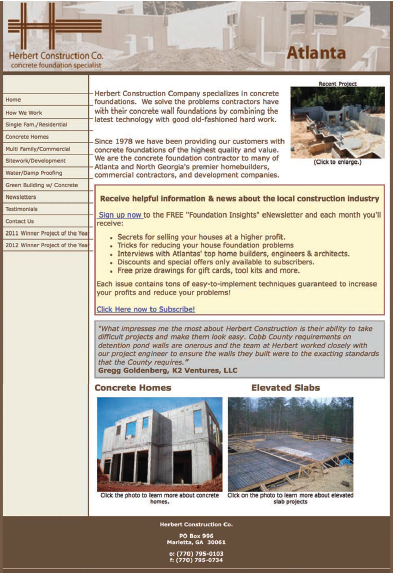
It is important to have a good, solid website that quickly and simply tells visitors:
- What you do
- Where you do it
- Why you are different and better than your competition
- How to contact you
If your website clearly conveys these four things, then it is a very effective sales tool. When someone is considering using your company, the first thing they do is perform an online search for you and your business. Your website needs to be there ready for them.
Your website doesn’t have to be the latest whiz-bang, award-winning design. But, it does have to convey why you are a better choice than any other contractor. This differentiation between you and your competitors is commonly referred to as your Unique Selling Proposition, or USP.
One other important aspect of your website is that it must be mobile responsive. This means that it has to be coded so that it is easily viewed on smart phones and tablets. The use of mobile phones and tablets is on the rise while desktop and laptop usage is on the decline. Be sure people can view your website on any of these devices.
2. Jobsite Signs
Don’t overlook the power of simple jobsite signs. Since concrete contractors are at the beginning of the building construction, your company sign is visible on each jobsite for a long time.
One of the top ways general contractors, homebuilders, and homeowners choose what contractor to contact is by looking for companies that work on projects similar to their own. Your jobsite sign will be seen by those people.
At my own concrete construction company, we have been using jobsite signs for over 22 years. We first heard about them from longtime CFA members Gary and Dan Bromley of ABI Corp. When they told us about the signs, we immediately had signs made and saw results with them right away.
For every one of those 22-plus years that we’ve used jobsite signs, they have been one of our top five ways of bringing in new customers.
3. Lead Tracking Sheet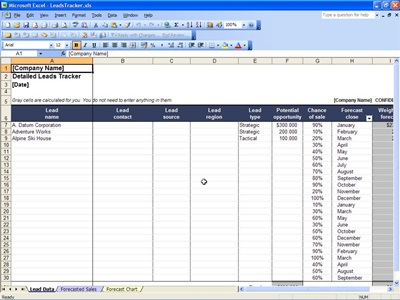
When a new prospect contacts your company by phone, email, website inquiry, or any other way, they are a called a “Lead.”
The million-dollar question is: “Why did that lead contact you?” Were they referred to you? Did they see a jobsite sign? Did they do a Google search and then clicked on your website?
It’s very important to record those leads as soon as they come in, as well as where they came from. You use a Lead Tracking Sheet to do just that.
When you know what sales and marketing tactics are bringing in the leads, you can increase your spending in those areas, and decrease your spending in the areas that are not bringing in the leads.
The Lead Tracking Sheet also tells you who referred the lead to your company. This allows you to thank the referrer, which encourages them to refer more people to your company.
4. Bid Log
This simple excel spreadsheet is used to record every estimate that you send out. It records the bid date, bid number, prospect/customer, project name, bid amount, and pricing structure.
You then use the Bid Log to follow up on those estimates. Once it is known whether you’ve won or lost the job, that info is entered into the spreadsheet, as well.
In addition to keeping all of your bidding activity recorded in one place, the Bid Log allows you to follow up on estimates that you’ve sent out, preventing projects from falling through the cracks. The Bid Log helps you see what’s in your pipeline – work to be bid, as well as projects you’ve won and will begin soon. It also allows you to gauge where the pricing is headed in your market because you track the outcome of jobs won and lost.
5. Thank You Cards
This easy, low-tech tool is extremely effective for getting more referrals, welcoming new customers, and thanking customers for the work.
Get cards imprinted with your logo. Use these cards to send hand-written thank you notes to those that refer you. Send them to your new customers to welcome them to your company. Send them to customers that paid quickly, thanking them for their work.
In a world of electronic communication – email, texts, tweets and likes – a hand-written note stands out like a Hawaiian Tropic model on a jobsite. Your note will be noticed, appreciated, and remembered. Do not underestimate how powerful this tool is to the success of your construction company.
6. Salesperson
This is the most difficult tool on this list to implement. You may be the one and only salesperson for your company. However, you also have a hundred other things you need to do each day.
A dedicated salesperson whose pay is tied to profitable sales and the effective management of customer accounts can be a game changer for your business. They can bring in a lot of new, profitable work for you.
In construction, most sales are still made by good old-fashioned, face-to-face selling. A salesperson can grow your sales faster than almost any other thing you can do. To learn more about hiring a salesperson, read my article in the previous issue of this magazine. I lay out the five questions to ask yourself to determine if one is right for your company.
Those are the six basic sales and marketing tools that every concrete contractor should be using every day.
Just as soccer players must first master the basics before moving on to more advanced moves, so do contractors with their sales & marketing. Get these basic tactics implemented and in use before anything else.
Don’t even think about venturing into the world of content marketing, Facebook ads or tweeting about your company unless you’re already really good at the basics above.
When contractors ask me about using advanced marketing tactics, here are some rules I tell them:
- Website before social media
- Thank You cards before content marketing
- Jobsite signs before online banner ads
- Print newsletter before paying for SEO
- Ad Retargeting before Google Adwords
Remember, you have to first master the basics. Then you can move on to the advanced techniques.
OK, I’ve gotta go now, I have to take my daughter to soccer practice.

ABOUT THE AUTHOR
Doug Herbert is President of Herbert Construction Co., one of the largest residential concrete contractors in the southeast. Doug is a regular presenter for the CFA and World of Concrete. He is the Founder of ProfitableContractor.com where he shows concrete contractors how to reduce their costs and increase their profits with effective sales and marketing systems. Reach Doug at Doug@ProfitableContractor.com
New Schwing S 38 SX Has Unique 5-Section Boom
November 10, 2016 (New Brighton, MN) – The new S 38 SX from Schwing combines a tight (22’ 10”) front outrigger spread with a lightweight (Federal Bridge Legal) design and a five-section boom with more articulation than any other boom style. The new model is available in a three-axle configuration with cab-over truck or as a four-axle version with conventional truck to meet federal bridge laws. “This is a concrete pump that defines versatility for concrete contractors and pumpers,“ states Tom O’Malley, senior vice-president of sales and marketing for the manufacturer, “The new boom design hyper extends at every section to exceed the capabilities of Roll and Fold and Z Booms.” Key features of this one of a kind Roll and Fold boom are that all of the articulation is on the working side of the boom for faster deployment and it has the ability to snake the end hose deep into decks. The boom provides 106’11” of horizontal and 122’4” of vertical reach.
Front outriggers are the exclusive Super X style that telescope out and around jobsite obstructions. For tight set ups, the outriggers can be deployed on one-side only with the standard EASy system that narrows the footprint and provides up to 180-degrees of boom rotation on the pour side of the pump. The system is integrated into Schwing’s VECTOR Controls that monitor and ensure the safety of the pump and its operator. The Vector system also provides proportional radio remote control of the boom function and communicates with the operator to stay fully informed of the pump’s status even when hundreds of feet from the pump.
Concrete pumping is provided by the proven Schwing open loop, twin-cylinder hydraulic pump that is offered in two sizes on the S 38 SX with output to 213 cubic yards per hour. Both pumpkits utilize the exclusive Rock Valve capable of pumping the harshest mixes while cleaning up with less water than other brands. The Schwing design with long stroke and large diameter pumping cylinders reduces wear by achieving pumping volume with fewer strokes per minute.
“This is the high utilization pump that will be requested daily because of this unique boom, “ explains O’Malley, “ It has the ability to place concrete where other booms cannot while providing fast set-up, maneuverability on-site and proven Schwing reliability.
For more information, visit www.schwing.com or call 1-888-SCHWING.
IRVING EQUIPMENT LLC ANNOUNCED AS EXCLUSIVE ATLAS GMBH CRANE IMPORTER AND PRIMARY DISTRIBUTOR FOR THE UNITED STATES OF AMERICA
September 15, 2016–Irving Equipment, LLC, located in Tiffin, OH USA, is pleased to announce their
recent contractual agreement with Atlas GmbH of Germany, and is now the exclusive importer and primary
distributor for Atlas Cranes in the U.S. market. All products will be sold through authorized Atlas
representatives. This deal will allow for full distribution of Atlas Crane products through dealers as well
as some direct sales. Additionally, Irving will offer work-ready truck and crane packages they have
assembled in the Tiffin facility.
Irving Equipment has recently expanded into a new facility, allowing for work on even the largest units
inside and unfolded, and offers a fully-equipped machining center and fabrication shop, as well as an
extensive spare parts inventory. Along with being the U.S. headquarters of Atlas Cranes, they will offer
sales, installation, and full service of the cranes along with boom inspection, repair and certification. The
new office complex houses an engineering center and state-of–the-art operator and mechanic training
areas. Irving Equipment is a family-owned and operated business, and is consequently able to provide
customers with the personal, individual attention and respect they deserve. The Irving family has over 145
years of combined experience selling and servicing hydraulic equipment with an extensive focus on
articulating cranes and their various applications.
Atlas has been manufacturing equipment since 1919, and is committed to providing their customers
with the highest quality products and services. From setting roof trusses and conduit, to precast vaults
and concrete wall forms, Atlas’ quality standards and customer satisfaction are measured in terms of
service performance and reliability. Under the ownership of Mr. Filipov and the leadership of Brahim
Stitou, Atlas has been increasing their market share by expanding their US dealer network. They are
committing to providing customers with the highest quality products and services.
For more info: Mark Irving Irving Equipment LLC Tele: 419-448-9891 mirving@irvingequipment.net
Hiring Two Ways
For most employers, hiring is a routine process that involves the same steps for everyone…Yet for many contractors this process is far too complex for their everyday hiring needs.
At CFA Convention 2016 I had the privilege of moderating a panel discussion on hiring practices with several members of the Board of Directors. They took turns describing some of the latest processes and resources they use, both successfully and not so successfully, to meet their growing needs for employees. During this discussion, the application process came up and was met with broad differences.
For most employers, hiring is a routine process that involves the same steps for everyone. Every applicant completes the same employment application, and if selected for an interview, completes the same interview process. If hired, each new hire goes through the same orientation process. This methodology provides simplicity and consistency in the hiring process. Yet for many contractors this process is far too complex for their everyday hiring needs.
While it is true that all concrete contractors will occasionally have to follow this approach, the fact remains that most of the time a shorter one is used. For example, when hiring office staff or professionals, the full-blown hiring process is always recommended. On the other hand, most contractors are constantly trying to hire field labor at least when they are pouring concrete. For this class of employee, the full-blown hiring process is often more than necessary and a waste of time. Instead, contrary to most labor and employment advisors, I recommend that contractors use a simplified, abbreviated hiring process for field labor.
The simpler hiring process starts with a slightly different focus on recruitment. In the traditional, or full-blown, hiring process you would want to advertise/recruit wherever possible. In contrast, in the simplified hiring process, you will want to focus on recruitment efforts that have yielded good workers in the past. Often, this will involve more word-of-mouth recruitment and may sometimes even involve paying recruitment bonuses to existing workers. After all, if you have a good worker, he or she may know friends or relatives who will also be good workers.
The next step in the process involves using a simplified employment application. For example, the simpler application may include only current contact information and relevant recent employment experience. For field labor you probably don’t care about education and employment experience that’s not relevant. In fact, you may not even care about criminal convictions, although that can be a little risky. Certainly, some questions contained in a full-blown employment application really are not relevant for field labor.
For example, questions about how long the applicant has lived in the area, hours available for work, schooling, possession of a driver’s license and driving record, typing, computer, or word processing skills, military service, and perhaps even references may be unnecessary when hiring field labor.
What you’re really seeking is relevant information about the applicant’s ability to perform the job. To that end, you will definitely want to know if the applicant has worked in the industry before, and if so, for whom and for how long. Although you need to be a little bit careful about disability discrimination, you will also want to know if the applicant has any physical or mental impairments which would prevent satisfactory job performance. Finally, you will want some contact information and perhaps an emergency contact. Ultimately, this makes the simplified hiring application no more than one page in length, which is a significant reduction from the normal 4 to 6 page employment application.
Other pieces of the hiring process will also be different. For example, for an office position you might review all of the applications and select a few people for interviews. In contrast, for field labor you are more than likely going to interview on the spot and make a hiring decision almost instantly. In that case, you will want to be sure to review the application before you actually talk to the applicant. That way you will be prepared to ask relevant questions, although in most cases the hiring decision will boil down to whether or not you think the applicant can do the work.
Reference checking is going to be optional for most field labor positions. In so far as the applicant indicates that they have prior experience in the construction industry, you probably want to ask for the name and phone number of a supervisor or manager at the prior employer. Even here, the reference checking process is a little different. Frankly, you probably don’t care if the applicant is eligible for rehire or not. In most cases, your real question is whether or not the applicant was capable of doing the work. Usually, you won’t care about the quality of work performed as much as the period of time that the applicant performed the work.
One aspect of the hiring process that should not be any different is pre-hire drug testing. Regardless of the nature of the position, you should always check for drug use. Specifically, you are most concerned with impairment rather than possession or use. Despite the increase in state legislation permitting medical and sometimes recreational marijuana use, it is still a federal crime. Perhaps most important, marijuana use results in impairment, and that poses risk to the individual in question as well as others working around him. That, in turn, exposes your company to risk. To date, even in those states that permit medical marijuana use, impairment at work is never permitted. Thus, you can and should conduct pre-hire drug and alcohol testing.
Finally, the orientation process may be different for field labor versus regular positions in your organization. This is so for several reasons. One, most field laborers will not have as much interest as other workers in things like benefits, promotion, job security, and the like. Second, most field laborers do not need to, or want to, be burdened by a bunch of rules. Notwithstanding that, it is important for you to go over certain basic rules and policies during orientation. These include basic safety rules and procedures, which you definitely want field labor to readily understand and abide by. Other policies to include in an orientation of field labor are non-harassment, nonretaliation, confidentiality, cell phone/smartphone usage, and perhaps a social media policy. You may also choose to use a shortened form of an employment handbook for field labor. The orientation period is an excellent time to introduce and go over that abbreviated employment handbook. You should be aware that for some employees English is not their primary language, and where that is the case it is a good idea to translate key portions of the orientation into their native language.
By following an abbreviated, simplified hiring process for field labor, you will save lots of time and energy but still get the basics done. Note however that no hiring process can completely eliminate the risk of hiring a L.U.Z.I.R. This is where an effective trial or probationary period will help you sort out the keepers.

IABOUT THE AUTHOR David C. Whitlock has been a lawyer for over 25 years. He specializes in Labor and Employment Law representing companies as they deal with complex federal, state, and local laws, regulations, and ordinances. If you have an employment-related compliance question, he can help you. David also spends a large amount of time helping companies employ foreign workers under the US immigration system. Business immigration is a complex and technical law practice, but David has excelled at it for over 25 years. Contact David Whitlock at 404-626-7011 (phone), davidcwhitlock@gmail.com or visit his website. David can also be met easily at CFA Convention each summer.
Overcoming Annoying Details and Situations
This issue’s ‘Trick of the Trade’ is shared by Dennis Purinton of Purinton Builders in East Granby, CT and current president of the CFA.
Everyone knows that if you put a couple of contractors in a room together, before long an idea will be shared that results in a brainstorm for the other. Put a dozen contractors in a room together and the number of ideas shared can be astounding. This is the truest value of a network built to bring contractors together to be better at their craft and to strengthen the overall industry.
With this in mind, we offer this corner to you, and challenge you to share some of your most ingenious or successful troubleshooting or time-saving techniques. All you need to do is send an email to executive director and editor, James Baty (jbaty@cfawalls.org). The email should contain the situation encountered and whatever you need to describe the solution that your company has come up with. Photos or sketches are required to help explain the “trick” to this forum.
If you are from an active CFA member company and your trick is selected for publication, your company will have 50 pts. placed in your account for Member Rewards redeemable for your CFA transactions. If you are from a company that is not a member, we will offer you a $100 discount on your first year’s membership fees…a great way to get to know the CFA.
Want even more benefit from sharing? Let us include your contact information with this trick and we’ll recommend anyone interested in learning more to contact you directly. When one cares to share, a light can be turned on. When all begin to share, the evolution of knowledge shines brightly for all.
DENNIS PURINTON challenges each of you to think about the ways you’ve overcome annoying details and situations to be more effective and economical in your work.
When I started forming with aluminum forms, I was always annoyed at the way the inside corners would be stuck between two sets of form ties. These metal straps were enough to hold these inside corners tightly. If we tried to cut the ties from one side, we risked marring the surface of the fresh concrete. If we tried to jerk the corners from the wall, we would spall the edges of the concrete at the tie locations.
One day, I picked up an anchor bolt, inserted it through the hole on the tie and pried it back away from the corner. The tie stayed in place and the bolt gave me the leverage to bend the tie back enough so you can now hit the tie with a hammer, braking off the tie. The tie breaks without damaging the corner or the surface of the concrete. It takes less than a minute to safely break off corner ties with no special tools. Everyone on strip day has a 1/2” anchor bolt in their back pocket.

The common 1/2-in. anchor bolt found on most residential concrete foundation projects. “Every one of our crew members carries one in their back pocket on strip day,” says Dennis Purinton.
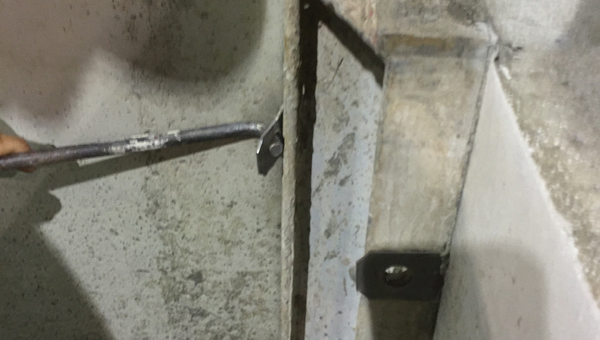
The anchor bolt end is inserted into the form tie hole and quickly pulled on to bend the tie end back. Used on each tie end, the aluminum corner form is easily removed.
Controlling the Costs Surrounding Worker Place Injury is in Your Hands
…you should consider that all injuries take a toll on your company. When considering work place injuries, you should examine your pre-accident and post-accident planning.
A new client recently told me during one of our first meetings, “Every day is risk”. That same new client two months later grieves over a fatality on their job site. The story behind the event goes like this… A contractor hired a sub-contractor to perform routine work. The contract with the building owner who hired the contractor states that the contractor is responsible for OSHA compliance. The contract between the contractor and sub-contractor states that the sub-contractor is responsible for all OSHA safety standards. The contractor relied on the sub-contractor’s agreement regarding the OSHA compliance. Following the fatality, and during the OSHA inspection, it was determined that no fall protection was installed prior to the commencement of work. Assigning responsibility for safety compliance in contracts is easy to do. It is, however, no guarantee that it will get done. Unfortunately, on that day the sub-contractor chose to avoid safety compliance caught up to them as a worker plunged to his death while walking backwards with no fall protection.
We have to focus on the following thought – Safety, while always a major consideration; it is said so often it sometimes losses its practicality. We know that production and safety go hand in hand and we know that you care about your workers; we also know you are running a business and need to be profitable, and sometimes, safety takes a backseat to production. Insurance carriers classify construction risks based on what they know to be true within the industry, meaning what each of you do individually will collectively impact all of you in the long run.
A Manhattan judge Friday found general contractor Harco Construction guilty of manslaughter in the trench-collapse death of immigrant worker last year in a verdict that could set a tougher new standard for criminal liability on construction sites. Judges Kirke Bartley also found the New York City company owned by Kenneth Hart guilty of criminally negligent homicide and three of four counts of reckless endangerment, boosting Manhattan District Attorney Cy Vance's effort to use criminal prosecutions to stem construction deaths in New York City.
This article is a follow up to the emerging risks article written for the last issue of Concrete Facts concerning “Emerging Risks”. CFA members taking the recent Heat Map Survey identified work place injury as one of the top three risks that impact their company’s bottom line. We all know that not all injuries are life-ending or permanently debilitating, but you should consider that all injuries take a toll on your company. When considering work place injuries, you should examine your pre-accident and post-accident planning.
Pre-Accident
Do you believe that your company culture is safety first? Take a moment to think about whether your safety program is an active part of each and every day your company operates or if it is in a file drawer tucked away for the next new employee to sign when they begin working? Unfortunately, during the majority of visits I make to contractors, the answer is the later of the two scenario’s, and the truth is that safety manual is a procedural document viewed as necessary, but not a routine plan implemented on all job sites. I’m challenging you to consider how you run your operation and think about the following questions:
- Do you consider the cost of safety compliance as equally important to production?
- Can you be competitive in your marketplace while being safe?
- Are your employees thinking about safety prior to engaging in a task?
- Is management committed to a safety culture?
- When accidents occur are you responsible?
- Do you blame the insurance company for paying claims?
- Do you believe that being a safe company can lead to a more productive workforce?
The research institute examined 2012 claims data (the most recent available) for injuries lasting six or more days and ranked the injuries by total workers’ compensation costs.
Let’s look at the ‘10 Leading Causes and Direct Costs of Workplace Injuries’ in 2012:
- Overexertion; paid costs $15.1B (25.3%)
- Falls on same level; paid costs $9.19B (15.4%)
- Struck by object or equipment; paid costs $5.3B (8.9%)
- Falls to lower level; paid costs $5.12B (8.6%)
- Other exertions or bodily reactions; paid costs $4.27B (7.2%)
- Roadway incidents involving motorized land vehicle; paid costs $3.18B (5.3%)
- Slip or trip without fall; paid costs $2.17B (3.6%)
- Caught in/compressed by equipment or objects; paid costs $2.1B (3.5%)
- Repetitive motions involving microtasks; paid costs $1.84B (3.1%)
- Struck against object or equipment; paid costs $1.76B (2.9%)
Production and project budget goals are often the source or at least a culprit of more than half of all injuries. Can you structure a valuable balance between production and safety? Do you post signs at your company that encourage “Safety First”? Do you incentivize your employees to put safety first as a practice on job sites? If so, do you walk the walk as well?
Or is the answer through other signs the message is really “Production First”? Obviously, no one would actually post contradictory signs that say, “Production First.” The hidden message takes other forms such as production pressures and number one crew status based on production output which then carries the underlying message that suggest production is the real No. 1 priority.
Your culture must integrate safety and production so employees are empowered to make the safe choices to make sure it really is “Safety First” at your company. Consider this loss as an example of why you should put safety first.
A four-million-dollar settlement was awarded to a worker on a swing stage scaffold who was going to quickly go up and make a quick fix and made the decision not to tie off to spare time. An apprentice iron worker above accidently cut the cable on the swing stage, when the secondary cable caught hold of the swing stage the force caused the worker to slam into the bottom of the scaffold and that same force crushed both of his ankles.
The injured worker has not walked since the accident described above. Ten minutes of solid safety training and implementation would have prevented this accident. Think about how you communicate your safety message through your company, what you can change, and whether it could be the answer to eliminating some work place injuries.
Do you falsely protect your company with the thought — It will happen to someone else, but it will not happen to me… General housekeeping on a jobsite drives a lot of frivolous injuries. Rebar on the ground caused a worker to trip and hit his head on the ground just in the right spot. He became a paraplegic within three days of the incident and the total cost of the claim was seven-million dollars before his death five years after. Trips and falls are real hazards that take a few minutes to correct. When the message is production first, employees hurry, and tend to walk over things verses moving them into their proper location. I once had a client tell me that before they hired anyone they would spy on the condition of the inside of their vehicle to see if they were neat enough to work for their company, odd, but effective thinking for housekeeping on a job site.
Post-Accident
Common Insurance Company Myths
- Insurance companies pay workers’ compensation claims because they like paying big settlements to injured workers so that they can charge you more money in the future in premiums.
- Insurance companies control the outcome of workers’ compensation claims, (in actuality, you do).
- Adjusters are solely responsible for managing workers’ compensations costs.
The fact is you can make the biggest impact on your workers’ compensation claim payment totals by actively managing your employee’s, safety compliance, training, and attitude by having a credible Return-to-Work Program.
Proper Treatment of Injured Employees Is an Important Element of Successful Return-to-Work Programs
In a study titled ‘It Pays To Be Nice: Employer-Worker Relationships and the Management of Back Pain Claims,’ published in the February 2007 edition of The Journal of Occupational and Environmental Medicine, Richard J. Butler PhD; William G. Johnson PhD; and Pierre Cote DC PhD discovered that workers’ satisfaction with their employer’s treatment of their disability claim is more important in explaining successful return-to-work outcomes than satisfaction with health care providers or expectations about recovery. The researchers added that dissatisfied workers have worse return-to-work outcomes because they are more likely to have lost time claims and multiple instances of joblessness.
The study found that the 64 percent of workers polled who were satisfied with their employer’s response had a medical claim only, while the 56 percent polled who expressed dissatisfaction had lost time claims in addition to the medical claims. For those workers who do have at least one lost time claim there is a lower likelihood of frequent injury-related absences. Only 32 percent of those satisfied with their employer’s response had multiple episodes of injury related absences, as opposed to 58 percent of those dissatisfied with their employer’s response who had multiple absences.
The best way to give the injured worker this sense of belonging is through frequent expressions of sincere regard and regular communication that keeps them in the loop. If the return-to-work program incorporates these two elements, it will accomplish the goal of reducing the probability of lengthy lost time.
In the end, it really is easier than it sounds. Safety culture is a top down mentality, from the owner of the company to the supervisors on the jobsite. As the owner, you must insist on the highest standard and hold your supervisors fully accountable for safe workplaces. As the owner, you have to stop yourself when evaluating production goals to make sure that safety compliance is a fair cost consideration in every job, and that it is an efficient process that won’t delay work performance when handling job safety. When making this evaluation, understanding that safety compliance has a cost is essential. Equally essential is knowing that the higher cost will always come when safety programs and procedures fail or are non-existent. Production and safety can work hand in hand but one deserves priority over the other at all times. At the end of the day, you want your employees to go home to their families and you want to be able to sleep at night. You have the ability to control Best in Class claims outcomes by taking ownership of the claim and your employee’s path to returning to work.

ABOUT THE AUTHOR Kristen Long is Managing Director of the Midwest Region – Construction Practice for Arthur J. Gallagher of Chicago, www.ajgrms.com. A.J. Gallagher is the broker for CFA Core360, the CFA’s member-only insurance program for complete and individualized business insurance lines specific to the cast-in-place concrete industry. You can reach Kristin at Kristen_Long@ajg.com.
Should You Hire A Salesperson?
Ask Yourself These Five Questions to Determine if One is Right for Your Company
For concrete contractors, there are few things that can bring in new work like a salesperson. In our line of work, most sales are still made by good old-fashioned, face-to-face selling. The right salesperson can grow your sales and increase your profits.
When I talk with concrete contractors around the country the topic of salespeople often comes up. They’ll ask, “How do I determine when the time is right to hire one?” And, “What’s the best way to pay a salesperson?” When determining if you should hire a salesperson, there are five questions you should ask yourself:
1. Is there work in my market that we could get by hiring a salesperson?
Do you see projects going up that you never got a chance to bid? Is the market growing while you seem to be losing market share? If a new salesperson concentrated on ten key accounts that are likely underserved by your competition, could you pick up six of them? If you answer “yes” to these types of questions, then a salesperson may make sense for you.
2. How will we pay a salesperson?
There are two ways to structure the compensation for a salesperson. The first is to pay them straight commission-only. This means they only get paid when they close a deal. The typical commission rate is between 7% and 10% of the project invoice. They would cover all of their expenses such as vehicle expense and gas. It is not common to find someone that will work on a commission-only basis.
The advantage of this method is that you only pay them when they bring in a project. The disadvantages are the high commission payout and you have less control over their day-to-day activities.
The second way to structure compensation is to pay the salesperson a base salary along with a commission for every sale. The commission rate is less than that of a commission-only salesperson. The base salary is relatively low, which compels them to continue to prospect for more work to get the commission pay in addition to their base salary.
For a salary plus commission salesperson you will also have a vehicle expense. This would either be a mileage reimbursement for the miles they put on their personal vehicle, or, you will provide them with a vehicle and pay for their gas and maintenance. Those expenses have to be included in your calculations.
The advantage of the salary plus commission method is that you have daily control over what they do and what prospects they target. The disadvantage is that you have to cover their expenses until they start to bring in a lot of sales.
One thing to consider when structuring your compensation plan is the salesperson’s involvement in managing the projects that they bring in. Will they simply hand the new project off to a project manager? Or, will they be required to manage the customer and/or the project throughout the entire process?
Whichever option you choose, be sure that their commission is paid after you get paid from the customer. You are paying them for bringing in paying customers, not deadbeats. Finally, check with your attorney to ensure your compensation complies with labor laws.
3. Can we afford a salesperson?
This can be the hardest question for you to answer. Analyze your financial statements and job cost reports. Then, get a feel for what the salesperson’s compensation package may look like.
Do your current sales cover your overhead expenses and produce a net profit? If so, then the gross profit brought on by a salesperson – minus their compensation – would go directly to the bottom line if you can you perform the additional work without adding to your overhead expense.
When the salesperson brings in a lot of work, then you will likely add office staff, trucks, forms or other equipment to handle the additional work. While it will add to your company overhead, it may not increase your overhead as a percentage of sales (overhead ratio).
Typically, a good salesperson will bring in sales that will require a small increase in overhead expense. Your new overhead ratio will often be less than your original overhead ratio, which is good. When your overhead ratio is lower, your profit ratio is higher.
In rare cases, hiring a salesperson would require you to make substantial equipment purchases and add a lot of office staff. This could severely affect cash flow and you may determine that it doesn’t make sense to hire a salesperson at that time.
There can be intangible benefits of more sales. Will the additional work allow you to retain good laborers instead of losing them during traditional soft spots in your schedule? Will you be able to utilize your concrete pump on more jobs? Will your waterproofing crew finally be busy with their current spray rig? It’s hard to place a financial number on these intangibles.
4. Can we cover expenses until the salesperson starts bringing in new business?
If you find a commission-only salesperson, then you don’t have to worry about covering the expenses until they make a sale. If you are considering hiring a salary plus commission salesperson, then you will have to cover their expenses until they bring in sales.
Once you have determined what you may pay a salary plus commission salesperson, ask yourself if you can cover the salesperson’s expenses once a month for five months. I don’t mean have five months’ reserve set aside. I mean can you come up with the salesperson’s salary and other expenses each month for five consecutive months? Concrete contractors are resilient, and we tend to find the money when we need it. You should see sales come in before the fifth month, so your goal should be to cover all expenses until then.
The speed at which a new salesperson will bring in new business varies greatly. For example, at my family’s concrete construction business, we’ve had a salesman bring in new business within the first two weeks. And, we’ve had a salesman that brought in very little for the first nine months before he was let go.
The salespeople that have early success seem to get it for these reasons: 55% comes from their existing network of contacts, 35% comes from relentless, fearless prospecting, and 10% comes from luck and good timing. (Tip: Look for a go-getter with a big rolodex and loads of self-confidence.)
In certain cases, it is faster to “buy” the work by hiring a salesperson with a lot of key contacts in your market. You are hiring their network more than their ability to call on cold prospects. In fact, these salespeople may not be especially good at cold-calling, but they have a big network that will use them. You may have to pay this type of salesperson more money to join your company.
One thing to consider is that this type of salesperson’s sales may plateau after they’ve gotten their network to use your company. Nevertheless, if they can bring in a lot of work quickly, it can often be worth it. The alternative may be that you bring on a newbie salesperson at a cheaper rate, but it takes them eight months to finally hit their stride and bring in sales. Many contractors don’t have the wherewithal to carry a salesperson that long.
5. Are we equipped to handle the additional work that may come to us?
What parts of your organization will be affected by an increase in sales? Will you need an additional estimator to handle the increase in bids? Will you need to buy more trucks or forms in order to get the work completed? Can you get enough skilled labor to do the additional work? Will the additional work allow you to fully utilize the manpower and equipment you already have on hand?
The additional work that comes from an effective salesperson has a snowball effect in your company. Be sure you anticipate any bottlenecks or problems that may come up from the added work.
A great salesperson can be a game changer for your business. When you ask yourself these five questions and really work through your answers, you’ll be on your way to determining if one is right for you.
About the Author:

Doug Herbert is President of Herbert Construction Co., one of the largest residential concrete contractors in the southeast. Doug is a regular presenter for the CFA and World of Concrete. He is founder of ProfitableContractor.com where he shows concrete contractors how to reduce their costs and increase their profits with effective sales and marketing systems. You can reach Doug by email at Doug@ProfitableContractor.com


